Juvederm Vs. Sculptra
Collagen is a naturally occurring structural protein responsible for keeping the skin tight, firm, and smooth in many areas of the face and body. As we age, natural collagen production decreases, emphasizing signs of aging, such as fine lines and wrinkles, creases known as smile lines or nasolabial folds around the nose and mouth, volume loss in the midface and under the eyes, sagging skin, the appearance of jowls along the jawline, and uneven skin texture. Some patients fear that the only way to combat these skin concerns is to seek out a plastic surgeon for a plastic surgery procedure, such as a facelift. However, this could not be further from the truth, as there are many non-surgical treatment options to boost collagen production for full skin rejuvenation and natural-looking results. When looking to combat volume loss and mild to severe wrinkles, one of the best options to turn to is a dermal filler, such as Juvederm or Sculptra, and the best first step to get started with your treatment plan is to schedule an appointment with expert board-certified dermatologist Dr. Michele Green in New York City.
Dermal fillers are non-invasive cosmetic injections that can be used to reduce the appearance of fine lines and wrinkles, fill in lost volume in the midface, contour the jawline, fill in acne scars, and de-emphasize stretch marks and cellulite on the body. Two of the most popular dermal filler treatment options are the Juvederm family of dermal fillers and Sculptra, which can serve similar functions but differ in their active ingredient. Juvederm fillers are hyaluronic acid fillers, meaning the active ingredient is hyaluronic acid, which helps to hydrate the skin and provides an immediate lifting and filling result. Sculptra, on the other hand, contains the active ingredient poly-L-lactic acid (PLLA), which is a collagen stimulator, triggering increased collagen production at the treatment site to tighten the skin, fill in lost volume, and erase fine lines and wrinkles. Neither treatment option is inherently better than the other, which is why it is always best to consult an expert injector like Dr. Green, who will take your aesthetic goals into account when selecting the best dermal filler for your treatment plan.
With over 25 years of experience, Dr. Michele Green, a renowned board-certified dermatologist, has been providing expert care to her patients in her Upper East Side New York City dermatology office. Her approach to dermal fillers, which emphasizes natural-looking results, has made her a trusted name in the industry. At Dr. Green’s office, she has many types of dermal fillers available to fit each patient’s unique needs, including Juvederm fillers, Sculptra, Restylane, and Radiesse. Dr. Green’s expertise extends to a wide range of cosmetic treatments, including dermal fillers, Botox, laser skin resurfacing, Kybella for reducing pockets of fat, chemical peels for facial rejuvenation, and many more. Her commitment to patient satisfaction has earned her recognition as one of the best dermatologists in New York City, as voted by publications such as Castle Connolly, Super Doctors, and New York Magazine.
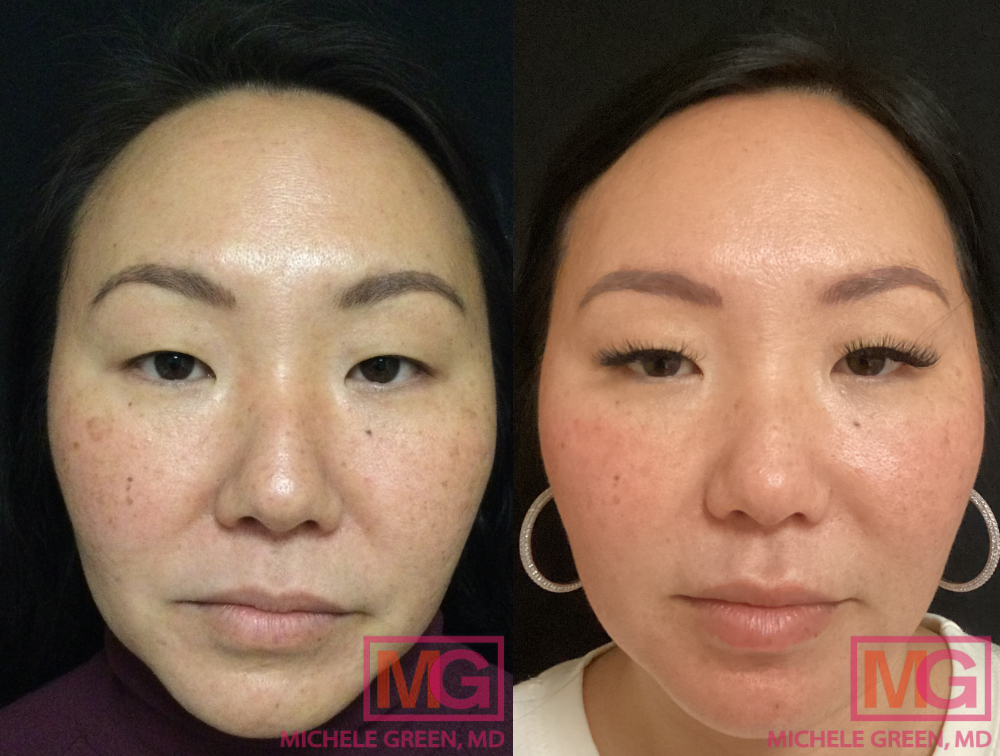
What is Juvederm?
Juvederm is a family of hyaluronic acid dermal fillers created by Allergan, the company known for making Botox Cosmetics. Each member of the Juvederm portfolio of dermal fillers contains the active ingredient hyaluronic acid, which attracts and binds water molecules for hydrated, plump, lifted-looking skin. First FDA-approved in 2006 to treat moderate to severe wrinkles and creases around the nose and mouth, including the nasolabial folds (smile lines), Juvederm treatment has since expanded to include a wide range of fillers, each with a different gel thickness and consistency to address different areas of the face:
- Juvederm Ultra XC – Reduces the appearance of mild to moderate creases, including nasolabial folds, smile lines, and marionette lines. This filler can also be used for lip augmentation.
- Juvederm Ultra Plus XC – Reduces the appearance of moderate to severe creases, including nasolabial folds, smile lines, and marionette lines. This filler can also be used for more dramatic lip enhancement.
- Juvederm Vollure – A type of Juvederm injection designed specifically for the nasolabial folds with long-lasting results (up to 18 months).
- Juvederm Volbella – Lip filler that is best for subtle enhancement. Juvederm Volbella is comprised of a thinner gel that works well in delicate areas, such as to fill in under-eye hollows.
- Juvederm Voluma – A thicker HA filler that was created to add volume to the cheeks and to restore lost volume in the midface. Juvederm Voluma can also be used along the jawline to reduce the appearance of jowls and create a more contoured look.
- Juvederm Volux – One of the newest members of the Juvederm portfolio, Juvederm Volux was created specifically for use along the jawline to contour and enhance the lower face.
What is Sculptra?
Sculptra is a type of dermal filler created by Galderma. It contains the active ingredient poly-L-lactic acid, a collagen stimulator that boosts natural collagen production in the treatment site for a firm, smooth, lifted look. Originally FDA-approved in 2004 to treat midface volume loss (lipoatrophy) in patients living with HIV, Sculptra was FDA-approved for general cosmetic use in 2009 and has since become one of the most popular dermal filler treatment options. On the face, Sculptra can be used to address volume loss in the midface, fine lines, and acne scars, and on the body, Sculptra works to reduce the appearance of cellulite and stretch marks. As Sculptra injections boost the body’s natural collagen production, it can take several months and up to three touch-up appointments for the full results to become visible. However, once the effects have taken hold, they can last for up to five years.
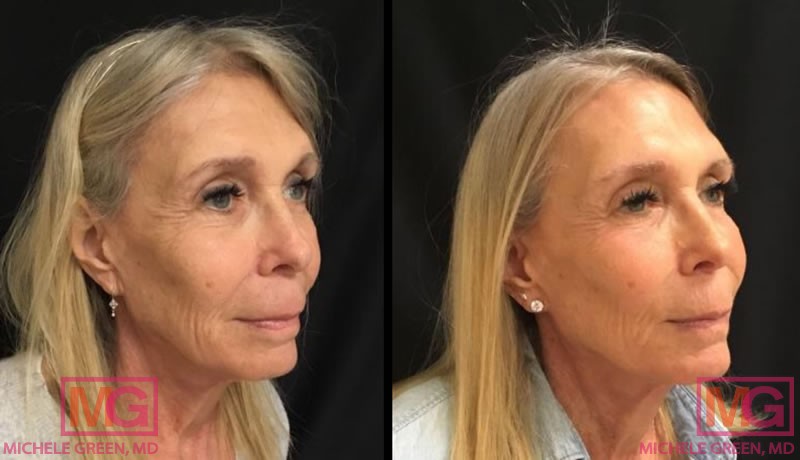
What is the difference between Sculptra and Juvederm?
Sculptra and Juvederm are both dermal fillers that are safe and effective for use on the face and body. The biggest difference between the two is the active ingredient and method of action for each treatment option. Juvederm fillers contain hyaluronic acid, which is a humectant, meaning it can bind water molecules up to one thousand times its weight, hydrating the skin for a smoother, firmer, plumper appearance. Sculptra, on the other hand, contains poly-L-lactic acid, which is a substance that triggers the natural production of collagen at the treatment site. Collagen is a naturally occurring protein in the body that provides structure, and increased collagen production helps to fill in age-related volume loss, wrinkles, and creases.
Due to their different active ingredients, Sculptra and Juvederm also differ in how long it takes for results to become visible and how long they last. The results of Juvederm treatment can be seen immediately after the injections and will remain visible for 9-18 months before the body completely dissolves the solution. As such, Dr. Green recommends receiving a touch-up appointment once or twice a year to maintain the results. Sculptra relies on the body’s natural collagen production, meaning that it typically takes three treatment sessions and 4-6 months for the results of the treatment to become visible. After those treatment sessions, the effects of Sculptra treatment can last for up to five years.
What is the difference between Botox and dermal fillers?
Botox and dermal fillers are both non-invasive injectable treatments, but they differ in how they work and why they are used. Botox is one of the most popular cosmetic treatments available. It is used primarily to reduce the appearance of dynamic wrinkles on the face, which are wrinkles that form due to repeated muscle movement, such as glabellar lines between the eyebrows that appear when you furrow your brow, forehead lines that appear when you raise your eyebrows, and crow’s feet that form at the corners of the eyes when you squint or smile. Botox treatment contains the active ingredient onabotulinum toxin type A, which is a neurotoxin that, when injected into a muscle, binds to neurotransmitters to essentially “freeze” the muscle, reducing its ability to contract. When the muscle relaxes, the dynamic wrinkles become smoothed out, creating a more youthful look. Botox and dermal fillers can be used together as they address different cosmetic concerns. While dermal fillers are used primarily to address volume loss in the midface, mild to severe nasolabial folds, jawline augmentation, and lip enhancement, Botox is used to address the dynamic wrinkles on the forehead and around the eyes.
What is the difference between Juvederm Voluma and Restylane?
Juvederm and Restylane are both HA fillers, but they are made by different companies (Allergan makes Juvederm, and Galderma makes Restylane) and have different formulations and cross-linking technologies. Juvederm Voluma is used specifically to address volume loss in the midface and contour the cheekbones. The equivalent in the Restylane portfolio of HA fillers is Restylane Lyft, which is also FDA-approved for reducing volume loss and hollows in the midface. The key difference between the two families of dermal fillers is that Juvederm filler has a smooth, gel-like consistency. In contrast, Restylane fillers are particulate gels, meaning they have a more granular consistency. Additionally, due to the cross-linking technology in Restylane fillers, they tend to be more cohesive but do not last quite as long as Juvederm fillers. Ultimately, both families of dermal fillers are safe and effective.
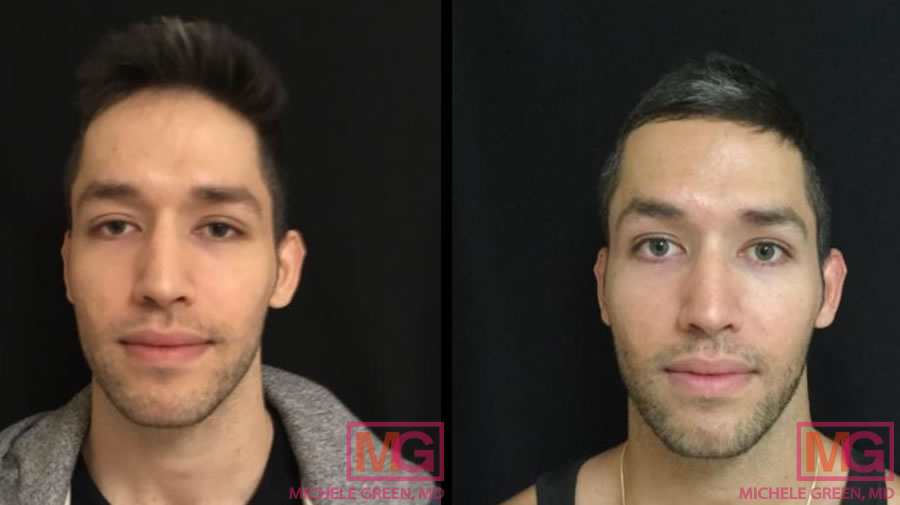
How is Juvederm injected?
The treatment process for Juvederm injections is simple when you visit an expert injector, such as board-certified dermatologist Dr. Michele Green in NYC. First, Dr. Green will have patients apply a topical numbing cream one hour before the injections to reduce any potential discomfort during the treatment. When patients arrive at Dr. Green’s office, she will clean off the numbing cream and sanitize the injection site before proceeding with the injections. The Juvederm fillers contain lidocaine within the injections themselves, which is a numbing agent – or anesthetic – that further reduces the risk of discomfort during treatment. After the procedure, Dr. Green will apply ice packs to the injection site to reduce the risk of swelling or bruising.
How is Sculptra injected?
Sculptra injections work very similarly to Juvederm injections. They begin with a topical numbing cream applied one hour before treatment and cleaned off once patients arrive for the procedure. The Sculptra dermal filler is injected deep into the dermal layer of skin, where it will boost collagen production for tighter, firmer, more youthful-looking skin. Following the injections, Dr. Green will massage the injection site for five minutes to help the Sculptra settle properly. She will then provide patients with skincare information for the days after the procedure, specifically the “rule of 5s,” where patients should massage the treatment area five times a day for five minutes for five consecutive days.
Where can you use Juvederm?
Juvederm hyaluronic acid filler injections can be used in various areas of the face and body for the following purposes:
- Midface for volume loss
- Cheeks for enhancement and contouring
- Lip augmentation
- Corners of the mouth and vertical lip lines
- Marionette lines
- Nasolabial folds
- Chin augmentation
- Jawline for contouring and reducing the appearance of jowls
- Tear trough (under eyes) for filling in lost volume
- Temples
- Hands
- Neck
- Acne scars
Where can you use Sculptra?
Sculptra poly-L-lactic acid dermal fillers can be used in several areas of the face and body for the following purposes:
- Midface to reduce volume loss
- Temples
- Marionette lines
- Nasolabial folds
- Décolletage
- Hips to reduce the appearance of hip dips
- Buttocks
- Hands
- Knees
- Upper arms
When can you see Juvederm results?
Juvederm dermal fillers provide patients with immediate results. Some patients may experience mild swelling in the treatment area for between two days and two weeks after treatment, but once the swelling has gone down, the results of the treatment will be fully visible. Juvederm fillers contain a cross-linking gel that provides immediate scaffolding for the skin, restoring lost volume, filling in creases, and augmenting the lips, cheeks, or jawline. Depending on the type of Juvederm filler that is used, the results of the treatment can last for six months to 24 months. Typically, Dr. Green recommends scheduling a touch-up appointment every six months to a year to maintain the full results of the treatment.
When can you see Sculptra results?
Because Sculptra takes advantage of the body’s natural collagen production process, the results of Sculptra injections take significantly longer to appear than Juvederm injections. Additionally, it typically takes three treatment sessions spaced one month apart each to achieve optimal results. In total, it can take four to six months for the full results of the treatment to become visible. However, Sculptra provides patients with dramatic and long-lasting results, with the effects of the treatment visible for up to five years. Typically, Dr. Green recommends that patients receive a touch-up injection approximately every two years.
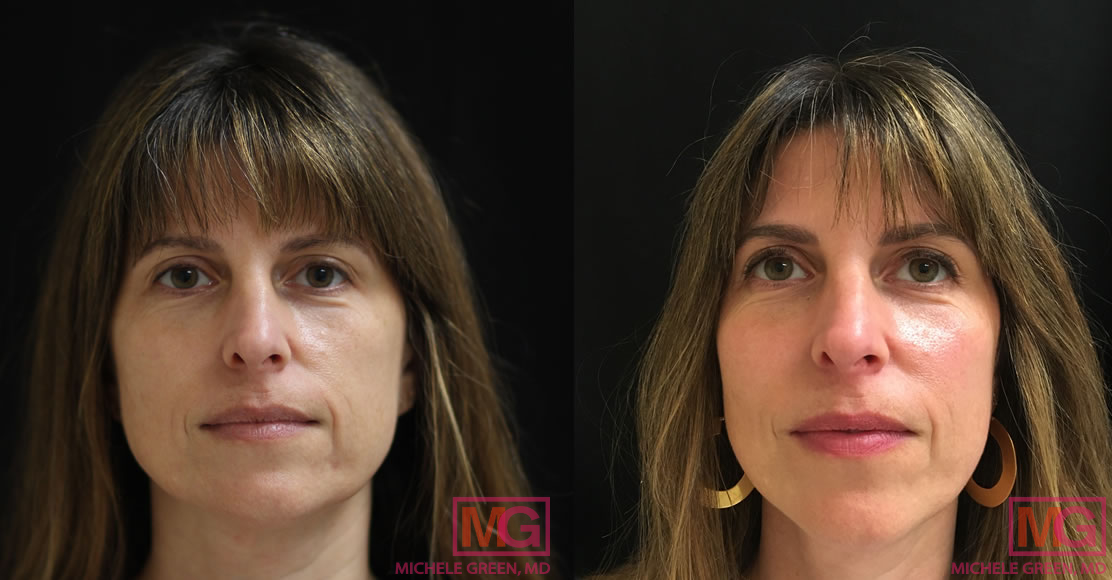
Is Juvederm or Sculptra safer?
Both Juvederm and Sculptra injections are safe and effective for restoring lost volume, reducing the appearance of fine lines and wrinkles, and overall reducing signs of aging for smoother, firmer skin. As with any injectable treatment, there is some risk of minor side effects, such as swelling, bruising, redness, or discomfort at the injection site in the days following the procedure. These side effects will typically go away on their own without the need for any intervention. Dr. Green does recommend that patients avoid taking blood thinners, such as Ibuprofen, Motrin, aspirin, and Aleve, in the two weeks leading up to the procedure to reduce the risk of bruising and swelling. One rare potential side effect is the injection of the dermal filler into a blood vessel, which can be very serious. This most commonly occurs when you seek treatment from a less experienced provider, which is why it is always safer to schedule an appointment with an expert board-certified dermatologist, such as Dr. Green.
Can you get bumps or swelling from Juvederm?
One of the common mild side effects of Juvederm injections is swelling at the injection site for up to two weeks post-treatment. One of the best ways to avoid swelling and bruising after treatment is to avoid blood thinners in the two weeks before the procedure and apply ice to the treatment site afterward. The development of little bumps or nodules is possible after Juvederm injections. If you notice bumps after a Juvederm injection, do not massage the treatment area. Rather, most bumps will settle on their own within two weeks of injections. If the bumps do not go away, the Juvederm HA filler can be dissolved with an injection known as Hyaluronidase.
Can you get bumps or swelling from Sculptra?
Bumps or nodules can form near the Sculptra injection site if the filler has been improperly diluted, the injection technique was poor, or patients did not properly massage the treatment area after the procedure. These nodules may be visible under the skin or merely felt when you press down on the treated area. Unlike Juvederm, which can be dissolved after injection with Hyaluronidase, Sculptra injections cannot be dissolved. If nodules occur, they may go away on their own after several years or be surgically removed. That is why it is essential to seek treatment from an expert dermatologist and follow the aftercare instructions precisely.
Is Sculptra more expensive than Juvederm?
The cost of dermal filler treatment will depend on several factors, including your geographic location, the type of institution at which you receive treatment, the scope of the treatment area, and your full treatment plan. The cost of Sculptra and Juvederm varies based on the geographical area and the quantity of vials used.
If you seek treatment from a MedSpa, there may be specials that bring down the price. However, the risk of developing serious side effects, such as injection in a blood vessel or nodules under the skin’s surface, greatly increases when you seek treatment from a less experienced provider.
Will Sculptra or Juvederm make more of a difference?
Both Sculptra and Juvederm are safe and effective treatments that provide patients with natural-looking results to combat signs of the natural aging process. As they are both great treatment options, Dr. Green will determine which one is best for you by discussing your aesthetic goals and unique needs. Once you have had your initial consultation, Dr. Green can make a recommendation for which dermal filler will best meet your goals.
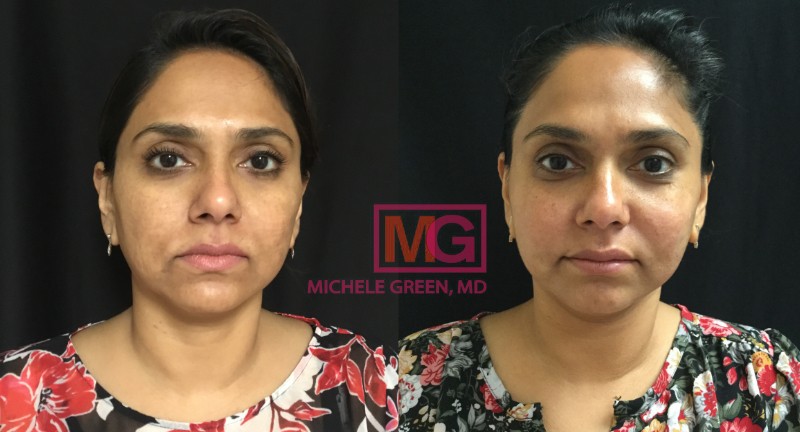
Can you get Sculptra and Juvederm together?
Sculptra and Juvederm can be paired together for full facial rejuvenation. Sculptra is intended primarily for filling in lost volume in the midface and reducing the appearance of moderate to severe nasolabial folds, whereas Juvederm can be used in these areas as well as the lips, under-eye hollows, and jawline. Depending on your aesthetic goals, Dr. Green may combine Sculptra for the midface with Juvederm for other facial contouring, creating a naturally youthful appearance.
Is Sculptra better than Juvederm? Is Juvederm better than Sculptra?
Sculptra and Juvederm are both excellent treatment options that work in slightly different ways. When generating your treatment plan, Dr. Green will choose the dermal filler treatment option that best suits your needs. For patients looking for more immediate results, Dr. Green may turn to Juvederm injections, which provide lift and support to the skin immediately after the procedure. Sculptra injections, on the other hand, can take four to six months to become fully visible, but the results of the treatment last much longer. While Juvederm treatment results can be seen for between six and 24 months, Sculptra results can last for up to five years. Both treatment options are equally good. As such, it is about finding which treatment is best for you.
How to get started with Sculptra and Juvederm dermal filler injections today
Dermal filler treatments are highly effective for reducing visible signs of the natural aging process, such as volume loss, creases, fine lines, wrinkles, jowls, and uneven skin texture. Sculptra and Juvederm are two types of dermal fillers that work differently but are both excellent treatment options. Sculptra is a poly-L-lactic acid-based filler that boosts collagen production over time for a naturally youthful look, while Juvederm is a hyaluronic acid-based filler with immediate results that can be used across many areas of the face and body. Neither filler option requires any downtime, meaning that patients can immediately return to their regularly scheduled activities. To find out which treatment option is the best for you, schedule your initial consultation with expert dermatologist Dr. Michele Green.
Dr. Michele Green is an internationally renowned board-certified dermatologist with over two and a half decades of experience providing her patients with the best non-invasive treatment options. Dr. Green takes a holistic approach and embraces a less-is-more philosophy, creating customized skincare routines and treatment plans that cater to the unique concerns and aesthetic goals of her patients. She is consistently identified as one of New York’s best dermatologists by Castle Connolly, New York Magazine, and Super Doctors for her dedication to her patients and expertise. Please call us at 212-535-3088 or email our New York City-based office today to schedule a consultation with Dr. Michele Green and find out which dermal filler option is best for you.
 212-535-3088
212-535-3088